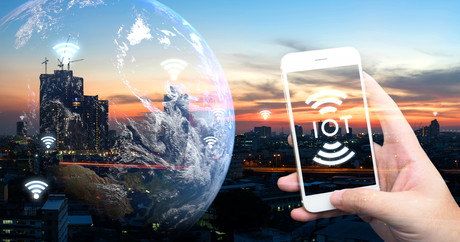Six expectations for IoT platforms in 2018

From increased value provided by edge computing to security improvements with blockchain integration, IoT platforms across the board are starting to get interesting.
The intelligent digital mesh is evolving and enterprises today are paying attention to the disruption and impact on business operations now and soon on the horizon. In this article, we look at new trends for IoT platforms in 2018 and what to expect as the year continues.
1. Pushing it to the edge
The evolution of computing and cost efficiency has made commercial devices capable of running full-on operating systems and complex algorithms, right in the office. IoT platforms in 2018 are continuing to push for the fastest connectivity and that’s of course where the concept of edge computing comes in; where workload is processed on the edge of the network where the IoT connects the cloud with the physical world.
A key part of this sequence is the fast and effective integration between IoT and the cloud, locating many of the processes on board the devices themselves and connecting them with the cloud for the most essential functions — ‘Elementary, my dear Watson’. As machine learning algorithms evolve and advance, so does the potential for edge devices to take over a growing percentage of computing data, combined with its ability to increase local privacy by not exporting sensitive data to the cloud plus reducing latency from data requirements. In 2018 we will continue to see an increased momentum of companies adding business solutions requiring local, secure data analysis, and edge computing will be a key focus of that implementation, with the benefits of the cloud for increased security, easy scalability, design configuration, simple deployment and management options.
2. Blockchain getting hotter
While BitCoin, LiteCoin and Ethereum have had their best climb and largest drop, before going back to a slow climb again in 2018, it is also likely to be the year that this technology enters widespread adoption through increased usage cases in IoT. As more and more devices are continually added to the IoT network, blockchain adoption promises to take security for users and companies to better levels as the year progresses. The fact is that every system of connected IoT devices can use blockchain to safely and reliably organise, store and share transactions of data. Over this year, this technology is expected to play a key role in the number of industries that manage physical objects moving across the planet, which could benefit from the many advantages of blockchain script, shifting focus towards large-scale deployments requiring reliability, stability and ease of integration with existing technology infrastructures. New pilot projects of positive use studies are emerging and blockchain technologies with IoT is a natural evolution that will drive adoption, making it one of the most significant trends for IoT software in 2018.
3. Beyond blockchain
Of course, as more devices are connected and as IoT expands, security challenges will increase as well. There will be more IoT-related risks both on devices and on the cloud network as hackers work to extract sensitive data by compromising systems, presenting new levels of concern and challenges to overcome in security design on the global infrastructure and for IoT platforms.
4. Expanding platform offerings
Designers building IoT into objects and experiences need functionality for remote product management, monitoring and control, and it’s the same for IoT business operators; they need data management platforms that integrate their diverse set of IoT-enabled business functions into easy-to-use business data they can leverage for managing the business, not manually sorting through a sea of bits of information. For functionality, they will increasingly choose IoT platforms that include built-in applications that are tailored for their needs.
Edge processing naturally leads to consolidation. As more companies push processing and data analysis to the edge of the network in order to improve security, reduce network latency and cut cloud costs, it will become increasingly attractive for an IoT platform to offer additional services to distinguish itself from other enterprise offerings. The ensuing pressure of supporting both edge and core with a cost-effective model will force all but the largest and most innovative IoT platform providers out of the market over the next few years or to focus their offering on niche applications.
5. Commercialise IoT data
Recent European guidelines recognise what 45% of data and analytics decision-makers at US enterprises are saying about commercialising data — they’re already doing it. In France, 35% of companies are doing it; in Germany, that number is 38%. Seeing the opportunity to level the playing field, the European Commission will issue guidelines this year to encourage the use of advanced data mining technology to boost the data economy with the advancement of IoT.
6. IIoT platforms leaving IaaS market
A part of ongoing consolidation and offering built-in applications for customers is that the major IIoT platforms have transferred at least some of their industry-based or IoT-specific functions available through hyperscale cloud providers like AWS, IBM and Microsoft. As these massive clouds extend their global reach, get clearance for compliance in a strict regulatory environment and solidify their own IoT capabilities, this trend will continue to unfold.
Conclusion
IoT platforms have an exciting year ahead for them as they adapt to the evolving environment of edge computing, blockchain and niche application support. The intelligent digital mesh is increasing in complexity and the security demands at all levels of the network are here to make the year even more interesting for software designers and platform engineers alike.
Avoiding EMC issues: simple tests you can do yourself
This is a brief overview of EMC compliance with some practical tips on not getting caught out.
Electric dump valves help oil and gas company reduce emissions
Oil and gas company Laramie Energy deployed ASCO zero-emissions electric dump valves to comply...
Australia's largest electronics expo returns to Sydney
Electronex, the annual electronics design and assembly expo, will return to Sydney on 19–20...





